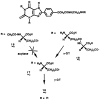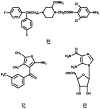Novel therapeutics acting via purine receptors
- PMID: 2018549
- PMCID: PMC3561777
- DOI: 10.1016/0006-2952(91)90555-j
Novel therapeutics acting via purine receptors
Abstract
A recent conference entitled Purines in Cell Signalling: Targets for New Drugs, held in Rockville, Maryland, in September, 1989, was one indication of the increasing interest in developing agonists and antagonists of P1-(adenosine) and P2-(ATP) purinoceptors [1] as potential therapeutic agents. Extracellular adenosine, acting at its membrane bound A1 and A2 receptors, is a ubiquitous modulator of cellular activity. The purine can arise from several sources including ATP hydrolysis by ectokinase activity in the region of the nerve terminal [2] and from S-adenosylhomocysteine [3] and ATP within the cell. Together with its more stable analogs, adenosine is a potent inhibitor of neurotransmitter release in both the central and peripheral nervous systems, and in cardiac, adipose and other tissues. Adenosine can also affect blood pressure and heart rate as well as modulate the function of the immune, inflammatory, gastrointestinal, renal and pulmonary systems, either via its effects on transmitter release or directly via receptor mechanisms altering intracellular transduction processes.
Figures



References
-
- Jacobson KA. Adenosine (P1) and ATP (P2) receptors. In: Emmett JC, editor. Comprehensive Medicinal Chemistry. Vol. 3. Pergamon Press; New York: 1990. pp. 601–642.
-
- Pearson JD. Ectonucleotidases. Measurement of activities and use of inhibitors. Methods Pharmacol. 1985;6:83–108.
-
- Stone TW, Lloyd HGE, Newby AC. Adenosine release. In: Williams M, editor. Adenosine and Adenosine Receptors. Humana Press; Clifton, NJ: 1990. pp. 173–223.
-
- Honey RM, Ritchie WT, Thompson WAR. The action of adenosine upon the human heart. Q J Med. 1930;23:485–490.
Publication types
MeSH terms
Substances
Grants and funding
LinkOut - more resources
Full Text Sources
Other Literature Sources

